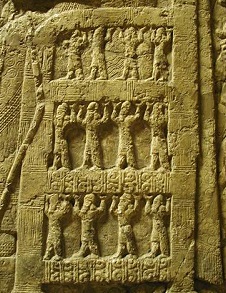I know I commented on the Hezekiah / Sennacherib story when we read it in Kings, but flying through it again in Chronicles makes me want to fill in the details by adding a little more info.
Hezekiah ascended the throne in 715 B.C. Just six years earlier, King Sargon II of Assyria conquered the northern nation of Israel. At that time, Assyria did not continue south to Judah because it was considered a loyal subject of the Assyrian king (a vassal state). The political turmoil caused by Sargon’s death (705 B.C.) led Hezekiah, and many other vassals, to make an attempt at independence. Sargon’s son, Sennacherib, ascended the Assyrian throne and had to immediately deal with internal instability and external rebellion.
While Sennacherib sought to secure his reign, Hezekiah went to work, fortifying his nation against the expected Assyrian response. He prepared for a siege by protecting Jerusalem’s water supply. He channeled the Gihon spring through the city by digging a 1,750 foot long tunnel through rock so that the water could now pool inside the city walls. Along with the tunnel he built walls and defensive towers to limit Assyrian access to the spring (2 Chronicles 32:5, Isaiah 22:11). But supplying water for his people was not going to be enough. Hezekiah also sought to limit water to the Assyrians by stopping up water sources in outlying regions (2 Chronicles 32:1-5).
Water supply wasn’t his only concern. Food may have also been on his mind. Archaeologists have found countless large jars scattered throughout ancient Judah, each one dating to the time of Hezekiah and bearing the inscription, “belonging to the king.” It is thought that these were used in various towns for storing food in preparation for a prolonged siege.
With water and food supplies secured, the time had come to secure the people. Hezekiah added “the Broad Wall” to western Jerusalem as well as an outer wall to the eastern side of the city. These expansions more than tripled Jerusalem’s size, likely as a way to provide space for the refugees who would come seeking shelter. Finally, we know that “He also made large numbers of weapons and shields” (2 Chronicles 32:5).
These preparations proved very helpful as in 701 B.C. Sennacherib began his campaign against Judah and others who rebelled in that area. The Sennacherib Prism is a 15 inch tall, six-sided clay annal of Sennacherib’s reign. It was discovered among the ruins of Nineveh (near current Mosul, Iraq) and contains the events of his campaign against the rebels in Palestine. Through it we learn that Sennacherib laid siege to 46 of Hezekiah’s fortified cities and surrounding towns (see 2 Chronicles 32:1, 9). It also recounts his advance through the coastal cities of Phoenicia and Philistia toward Jerusalem. This was a terrifying assault where the soldiers “slew…nobles who had provoked rebellion and hung their bodies on watchtowers.” Knowing this sheds new light on how the people heard the words from the army commanders (2 Chronicles 32:13-19) and why it is that Jonah did not want to go and preach to the folks at Nineveh. Even so, the Prism states that Sennacherib did not capture Jerusalem. Instead, all he could do was “shut up Hezekiah in Jerusalem like a bird in a cage.”
The brutality of this campaign is highlighted in what is known as The Lachish Reliefs. In 1850, twelve stone slabs were discovered in Sennacherib’s palace. When combined, these slabs comprise a single work measuring 8 feet tall by 80 feet long and would have wrapped around the throne room. The pictures were a vivid retelling of Sennacherib’s victory over the fortified town of Lachish, one of the towns guarding access to Jerusalem. If an army wanted to get to Jerusalem, they would need to take Lachish first and taking Lachish would be no easy task.
The overlap between biblical and extra-biblical accounts of this period deepen our understanding of this moment and strengthen our confidence in the historical accuracy of the biblical text. Now, “gaps” can be found and questions will arise when comparing most ancient histories; this is the case with Sennacherib and Hezekiah. The primary question has to do with the number of invasions. Did Sennacherib come once or twice (701 is certain, but did he return again in the mid 680’s)? Whether it was one invasion or two, the facts remain clear—Hezekiah trusted God, went to great lengths to protect his nation and Sennacherib was not able to take Jerusalem.

Before I close, we need to address the question of why Sennacherib pulled out without attacking the goal of his campaign. In 2 Kings 19:5-7, Isaiah tells Hezekiah that the Assyrian king will hear a report and return to his own country where he will be killed by the sword. History records that the report he heard was likely that Egypt’s king Tirhakah was marching out against him. Normally, this would have been an opportunity for the victorious Assyrian troops to go after an even bigger prize, but a badly timed plague had just wiped out 185,000 of his troops. In this weakened state, Sennacherib had no choice but to pull back (2 Kings 19:35-36).
I don’t know about you but I am intrigued by this kind of comparison. God let Sennacherib come right up to Jerusalem’s door before He put into play events that would stop this unstoppable force. I am sure the folks in the 46 conquered towns thought the fight was over and once Lachish fell everyone was sure Jerusalem was next.
After hearing of Assyrian victories and atrocities, it would have been very hard for the citizens and refugees in Jerusalem to hold fast to Hezekiah’s faith. I know I would have been tempted to think that the king was crazy to believe the only way out of this is to trust in God and I am sure that even after the Assyrians pulled out, some thought that the plague and retreat were nothing more than a happy coincidence.
Hezekiah was a godly king. He worked hard, prepared for the inevitable and trusted God. He prepared and he trusted. Then, even when all of his preparations and plans seemed to fall apart, he continued to trust God, laying out the need before the Lord. What lessons does the Lord have for me in this? What lessons does He have for us?
Oh Lord, open our eyes that we might see your work in our lives, our nation and our world, no matter what the circumstances might suggest.
Looking expectantly with you,

Rob






